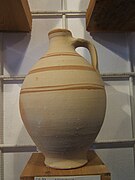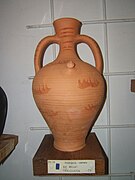Category:Cántaros
Jump to navigation
Jump to search
English: In Spain receive the name of "Cántaro", a simple earthenware jar, pitcher or jug ;[1] vessels oval profile, narrow mouth and foot and usually without handles. Has been traditionally used to store wine, and the medium-sized copies for cereal grains and oil. The iconographic symbol of the spanish water sellers.
"Cántaro" is a term from Greek origin, «κάνθαρος», poured into latin as «cantharus», jug. It has been a traditional and somewhat emblematic of the culture and pottery of the water, with abundant archaeological documentation. There are news of its existence from the primitive Hebrew texts of the Old Testament (passages devoted to Gideon, Moses or Rebecca and Eliezer); presence that is continued in the New Testament, in stories such as the Samaritan woman giving Christ a drink or at the wedding at Cana. It continues then appearing in Roman literature, as well as the philosophical and mystical texts of Al'Andalus, notably in Arabic poetry in the taifa kingdoms. Its utility and application in the countries of the consumer society have almost disappeared, becoming the pitcher into an object of ethnographic interest and part of collecting.
Español: Cántaro es un recipiente o vasija hecho de barro o de algún metal u otro material impermeable, que sirve para guardar, conservar y transportar líquidos. De forma ovoide, con la boca y la base de apoyo más estrechas, puede disponer de una o más asas. Se fabrica en diferentes tamaños, sirviendo el mayor —de unos diez litros— como medida. Por extensión, también se ha llamado cántaro al contenido del recipiente: un cántaro de leche, un cántaro de vino, etc.
Cántaro es término de origen griego, «κάνθαρος», vertido al latín como «cantharus», jarro. Ha sido un objeto tradicional y en cierto modo emblemático de la cultura y la alfarería del agua, con abundantísima documentación arqueológica. Hay noticia de su existencia desde los primitivos textos hebreos, del Antiguo Testamento (pasajes dedicados a Gedeón, Moisés o Rebeca y Eliezer); presencia que se continua en el Nuevo Testamento, en historias como la de la mujer samaritana que da de beber a Cristo o en las bodas de Caná. Continúa luego apareciendo en la literatura romana, así como en los textos filosóficos y místicos de Al-Ándalus, en especial en la poesía árabe en los reinos de taifas. Su utilidad y uso en los países de la sociedad de consumo casi han desaparecido, convirtiéndose el cántaro en un objeto de interés etnográfico y en pieza de coleccionismo.
Português: Cântaro
In Spain receive the name of "cántaro", a simple earthenware jar, pitcher or jug, vessels oval profile, narrow mouth and foot. It can have two, one or no handles. | |||||
| Upload media | |||||
| Instance of | |||||
|---|---|---|---|---|---|
| Depicts | drinking vessel and physical container | ||||
| |||||
Subcategories
This category has the following 8 subcategories, out of 8 total.
Media in category "Cántaros"
The following 16 files are in this category, out of 16 total.
-
Alfareria de Moveros cantara de dos cuerpos lou.jpg 1,536 × 2,304; 352 KB
-
Andalusien 2013 (15273715847).jpg 2,592 × 3,888; 2.87 MB
-
Botija de Puertollano Ciudad Real Spain.JPG 418 × 570; 50 KB
-
Cantarilla de Priego (Cuenca).jpg 983 × 1,311; 180 KB
-
Cantaro.JPG 2,848 × 4,288; 2.99 MB
-
Càntirs al museu etnològic de Castelló de la Plana.JPG 3,559 × 2,525; 1.21 MB
-
Cántara de Traiguera (Castellón).jpg 983 × 1,311; 195 KB
-
Cántara-Miranda-Avilés.jpg 576 × 640; 171 KB
-
Cántaro Anguita, Guadalajara Spain.JPG 311 × 507; 16 KB
-
Cántaro de Moveros.jpg 2,104 × 2,744; 582 KB
-
Cántaro de novia (Talarrubias, Badajoz, Spain).jpg 336 × 474; 35 KB
-
Cántaro of Mallorca.jpg 1,704 × 2,272; 547 KB
-
Céramique-Sainte-Barbe-stockage et transport.jpg 3,829 × 2,553; 1.32 MB
-
Faro (1).jpg 422 × 640; 147 KB
-
Faro (2).jpg 430 × 640; 146 KB
-
Jug on the table.JPG 800 × 600; 97 KB
















